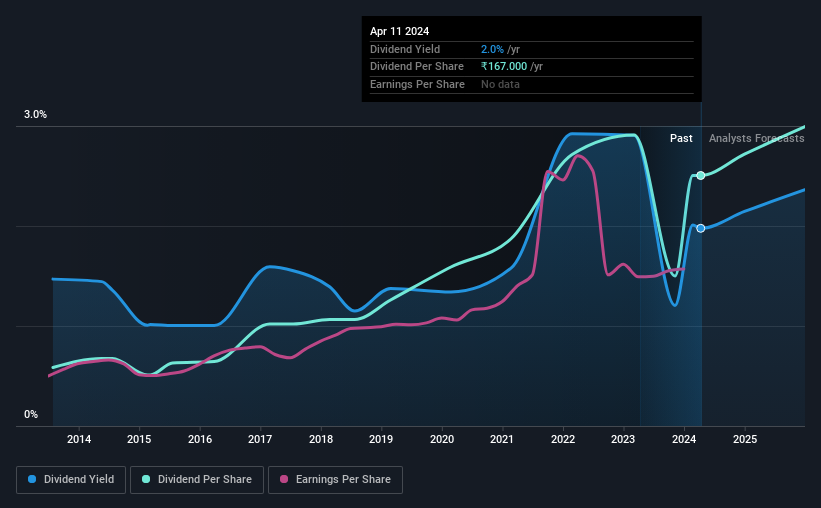
Sanofi India Limited's (NSE:SANOFI) investors are due to receive a payment of ₹117.00 per share on 13th of June. However, the dividend yield of 2.0% is still a decent boost to shareholder returns.
See our latest analysis for Sanofi India
Sanofi India's Dividend Is Well Covered By Earnings
Impressive dividend yields are good, but this doesn't matter much if the payments can't be sustained. The last payment was quite easily covered by earnings, but it made up 196% of cash flows. While the company may be more focused on returning cash to shareholders than growing the business at this time, we think that a cash payout ratio this high might expose the dividend to being cut if the business ran into some challenges.
Over the next year, EPS is forecast to expand by 31.4%. Assuming the dividend continues along recent trends, we think the payout ratio could be 58% by next year, which is in a pretty sustainable range.

Dividend Volatility
The company's dividend history has been marked by instability, with at least one cut in the last 10 years. Since 2014, the annual payment back then was ₹39.00, compared to the most recent full-year payment of ₹167.00. This works out to be a compound annual growth rate (CAGR) of approximately 16% a year over that time. Dividends have grown rapidly over this time, but with cuts in the past we are not certain that this stock will be a reliable source of income in the future.
We Could See Sanofi India's Dividend Growing
With a relatively unstable dividend, it's even more important to evaluate if earnings per share is growing, which could point to a growing dividend in the future. It's encouraging to see that Sanofi India has been growing its earnings per share at 9.6% a year over the past five years. The company is paying out a lot of its cash as a dividend, but it looks okay based on the payout ratio.
In Summary
Overall, it's not great to see that the dividend has been cut, but this might be explained by the payments being a bit high previously. While Sanofi India is earning enough to cover the payments, the cash flows are lacking. We would probably look elsewhere for an income investment.
It's important to note that companies having a consistent dividend policy will generate greater investor confidence than those having an erratic one. At the same time, there are other factors our readers should be conscious of before pouring capital into a stock. Case in point: We've spotted 2 warning signs for Sanofi India (of which 1 doesn't sit too well with us!) you should know about. If you are a dividend investor, you might also want to look at our curated list of high yield dividend stocks.
New: Manage All Your Stock Portfolios in One Place
We've created the ultimate portfolio companion for stock investors, and it's free.
• Connect an unlimited number of Portfolios and see your total in one currency
• Be alerted to new Warning Signs or Risks via email or mobile
• Track the Fair Value of your stocks
Have feedback on this article? Concerned about the content? Get in touch with us directly. Alternatively, email editorial-team (at) simplywallst.com.
This article by Simply Wall St is general in nature. We provide commentary based on historical data and analyst forecasts only using an unbiased methodology and our articles are not intended to be financial advice. It does not constitute a recommendation to buy or sell any stock, and does not take account of your objectives, or your financial situation. We aim to bring you long-term focused analysis driven by fundamental data. Note that our analysis may not factor in the latest price-sensitive company announcements or qualitative material. Simply Wall St has no position in any stocks mentioned.
About NSEI:SANOFI
Sanofi India
Manufactures and trades in drugs and pharmaceutical products in India, Singapore and internationally.
Excellent balance sheet, good value and pays a dividend.


